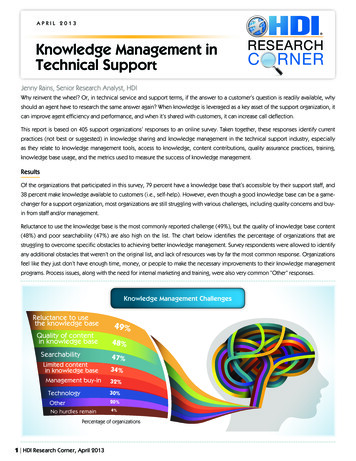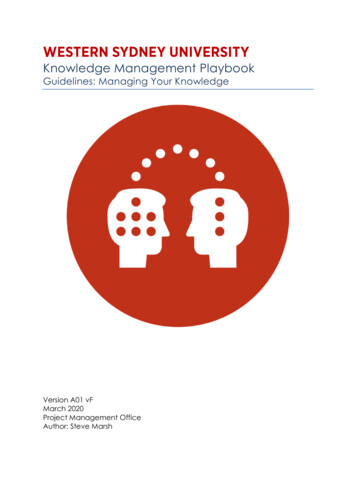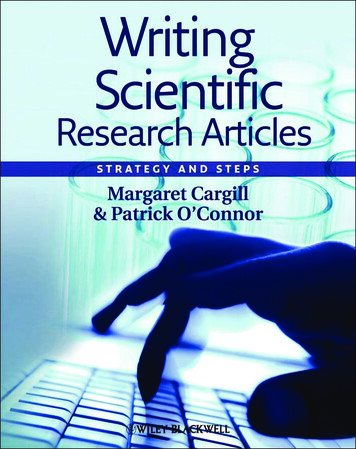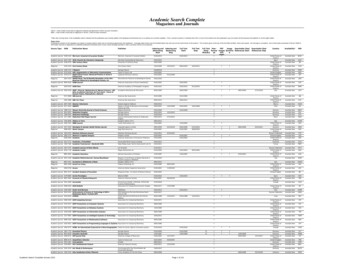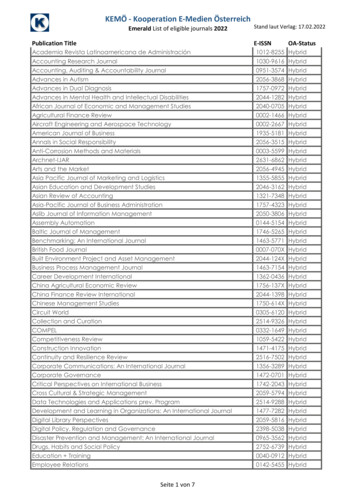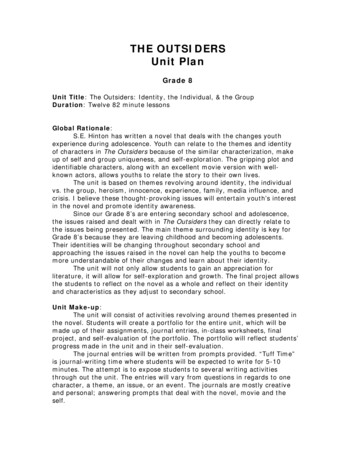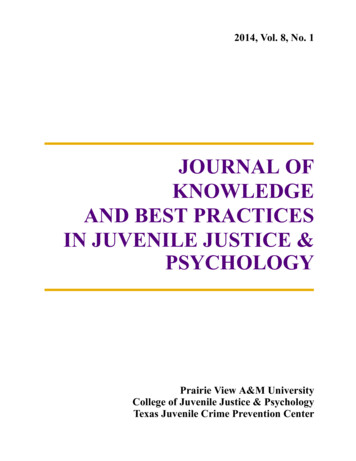
Transcription
2014, Vol. 8, No. 1JOURNAL OFKNOWLEDGEAND BEST PRACTICESIN JUVENILE JUSTICE &PSYCHOLOGYPrairie View A&M UniversityCollege of Juvenile Justice & PsychologyTexas Juvenile Crime Prevention Centerii
2014 College of Juvenile Justice & Psychology, Texas Juvenile Crime Prevention Center, Prairie View A&M University.All rights reserved.ii
The College of Juvenile Justice and Psychology at Prairie View A&M University invites papers for publication in theJournal of Knowledge and Best Practices in Juvenile Justice & Psychology. The journal seeks relevant applicationresearch for the academic and practitioner communities of juvenile justice, psychology, and criminal justice. The editorial staff is soliciting both qualitative and quantitative articles on juvenile justice policy, delinquency prevention,treatment, and evaluation. The journal is published in hard copy and electronically. All articles submitted for reviewshould be sent electronically to the senior editor gsosho@pvamu.edu. The articles should follow the APA style and betyped in 12 point font. All inquires and submissions should be directed to the senior editor.All submissions must be done electronically and manuscripts will be promptly refereed. Reviewing will be double-blind. In submitting manuscripts, authors acknowledge that no paper will be submitted to another journal duringthe review period.For publication in Journal of Knowledge and Best Practices in Juvenile Justice & Psychology: Manuscripts must follow the APA style (as outlined in the latest edition of Publication Manual of the AmericanPsychological Association.) The title of all papers should be centered and typed in caps on the first page with 12 point font. The title page must include the name, affiliation, title/academic rank, phone number, and the email address of theauthor(s). Submission of an electronic copy in MS Word as an attachment to co-editor: gsosho@pvamu.edu maximum of 25pages with references and tables. The submission must be entirely original. All papers must be typed, double-spaced, on regular 8.5" x 11" paper, and fully justified with margins set to 1-inchtop, bottom, left, and right with 12 point font. Acknowledgment should be placed before references. Manuscripts that meet the above requirements will bepublished in the forthcoming volume of The Journal of Knowledge and Best Practices in Juvenile Justice &Psychology.Editor-in-ChiefTamara L. Brown, Ph.D.Dean, College of Juvenile Justice & PsychologyExecutive Director, Texas Juvenile Crime Prevention CenterPrairie View A&M UniversityPrairie View, TX 77446Phone: (936) 261-5205Senior EditorGbolahan S. Osho, Ph.D.Associate Professor, Department of Justice StudiesPrairie View A&M UniversityPrairie View, TX 77446Phone: (936) 261-5236iii
Journal of Knowledge and Best Practices in Juvenile Justice and PsychologyEditor-in-ChiefTamara L. Brown, Ph.D.Dean, College of Juvenile Justice & PsychologyExecutive Director, Texas Juvenile Crime Prevention CenterPrairie View A&M University, Prairie View, TexasSenior EditorsGbolahan S. Osho, Ph.D.Associate Professor, Department of Justice StudiesPrairie View A&M University, Prairie View, TexasEditorial Advisory BoardErin Espinosa, University of Texas, Austin, TexasDelores James-Brown, John Jay College, New York, New YorkIhekwoaba Onwudiwe, Texas Southern University, Houston, TexasSusan Ritter, University of Texas, Brownsville, TexasBarbara Scobey, Texas Department of Aging and Disability Services, Austin, TexasAlejandro del Carmen, University of Texas, Arlington, TexasKathryn Sellers, Kaplan University, Boca Raton, FloridaDonna M. Vandiver, Texas State University, San Marcos, TexasScott H. Belshaw, University of North Texas, Denton, TexasPublished by The College of Juvenile Justice and Psychology, Texas Juvenile Crime Prevention Center.Prairie View A&M University.iiii
Journal of Knowledge and Best Practices in Juvenile Justice and Psychology 2014 College of Juvenile Justice and Psychology at Prairie View A&M University2014, Vol. 8, No. 1, iii-ivThe Juvenile Adjudicative Competence Interview (JACI): Current Usage in Juvenile Competence to StandTrial Evaulationsby Tomei and Panza .1Implications for the Topological and Vector Management of Schizoid Dynamicsby Woods . 11The Life Course Perspective of Delinquency: An Empirical Analysis of Female Juvenile Offending fromthe National Youth Surveyby Piper .21Experimental Community-Based Interventions for Delinquent Youth: An Evaluation of Recidivism andCost-Effectivenessby Early, Ryon, Hand, and Blankenship .29Aggregate Correlates of Status Offender Case Outcomes Across Countiesby Bowers and Costanza .37Mississippi Juveniles Adjudicated as Adults and Held in Adult Jails: The Perspective of the County Sheriffby Hilal, Eckberg, and Osowski. 45Discipline and the Pipeline to the 'Pen': A Proposal for Changeby Kellum-Gilbert . 55iiiiv
Journal of Knowledge and Best Practices in Juvenile Justice and Psychologyiviv
Journal of Knowledge and Best Practices in Juvenile Justice and Psychology 2014 College of Juvenile Justice and Psychology, Texas Juvenile Crime Prevention Center at Prairie View A&M University2014, Vol. 8, No. 1, 1-10The Juvenile Adjudicative Competence Interview (JACI): Current Usage inJuvenile Competence to Stand Trial EvaulationsJenna Tomei, M.S.Nancy Ryba PanzaSam Houston State UniversityCalifornia State University, FullertonMental health experts are often asked to assist the courts in making relevant legal decisions,such as a defendant's competence to stand trial. Many competence assessment instruments havebeen developed for adults, however, the Juvenile Adjudicative Competence Interview (JACI) isthe only measure developed specifically for a juvenile population. Currently, there has been noresearch done to evaluate the effectiveness of this tool. The purpose of this study was to explorethe use of the JACI and to assess its usefulness in aiding examiners' opinions of competency.Data was drawn from 110 forensic evaluations, 55 in which the JACI was utilized and 55without. A coding scheme was used to assign passing/failing scores for all items on the JACI.Findings indicate that the JACI responses strongly influenced practitioner's ultimate opinionswith Section 1, Assessing Knowledge of the Juvenile Court and its Consequences, being themost influential of the four sections and Content Area 5, Role of the Prosecutor, being the mostinfluential individual topic. Both understanding and appreciation items were strong predictorsof final outcome. A diagnosis of Mental Retardation was a strong predicate to incompetence;and, while general psychological testing was used with equal frequency in evaluations with andwithout the JACI, additional forensic instruments were used significantly more in evaluationswithout the JACI. Overall, the results of this study show the JACI to be a strong predictor offinal competence recommendations and that this instrument is likely to be a valuable tool injuvenile competency examinations.Keywords: adjudicative competence, competence to stand trial, juvenile justice, forensicassessmentEvaluating Competence to Stand TrialTo be competent to stand trial a defendant must have a factual and rational understanding of the charges, court proceedings,and possible consequences, as well as the ability to consult withhis or her lawyer (Dusky v. United States, 1960). While competence to stand trial for juveniles was historically irrelevant, theshift within the juvenile justice system away from a rehabilitative focus and toward a more formal and punitive focus has increased the need to ensure that juveniles are competent to standtrial (Grisso, 1998; 2005). While debate still exists over the definitions and standards of competence to be used, most stateshave acknowledged the right to competence within the juvenilecourt system (Redding & Frost, 2001). Further, research in therecent past has begun to illuminate factors that are likely toplace a juvenile offender at a greater risk for incompetence.Such factors include: being below age 15, having a seriousmental illness or significant deficits in cognitive functioning, orthe presence of developmental immaturities that interfere withcompetence-related abilities (Cooper, 1997; Grisso, 1981;2003; 2005; Grisso et al., 2003; Hoge et al., 1997; McKee,1998).Mental health experts are often called upon by the courts toconduct evaluations that assist in determining whether an offender is competent to stand trial. In their evaluations, practitioners are tasked with determining whether an offender has anydeficits in competence-related abilities as specified in the legalstandard for competence. In doing so, it is common for evaluators to use a variety of assessment tools including objective personality instruments, projective personality tests, cognitive andintelligence tests, neuropsychological tests, and forensic instruments (Borum & Grisso, 1995). Unlike standard psychologicaltests, forensic instruments aim to bridge the gap between clinical and legal constructs and are designed to more directly evaluate the legal capabilities of a defendant. Over the past 40 years,more than a dozen competence assessment instruments (CAIs)have been developed to assist practitioners in evaluating one'scompetence related abilities (Grisso, 2003; Pirelli, Gottdiener,& Zapf, 2011). These CAIs range from informal checklists tomanualized interview schedules to criterion-based assessmentscombining both formats (Pirelli, Gottdiener, & Zapf, 2011). It isthought that having these instruments available will help practitioners assess clinical characteristics of a defendant, while alsostaying focused on the legal issue at hand.Correspondence concerning this article should be addressed to JennaTomei, Sam Houston State University. E-mail: jlt046@shsu.edu110
2TOMEI & PANZAThe increased demand for competence evaluations for juvenile offenders has led practitioners to employ many of thesemeasures in juvenile proceedings. In fact, research indicatesthat many clinicians conducting competence evaluations for juveniles believe in the importance of using CAIs in their assessments (Ryba, Cooper & Zpaf, 2003). However, a study conducted by Christy, Douglas, Otto, and Petrila (2004) revealedthat out of 1,357 reports conducted by 257 forensic examiners,the use of these tests was very inconsistent. These contradictoryfindings are likely explained by the fact that none of these CAIswere designed for, or normed, on children and/or adolescents(Christy et al., 2004; Roesch, Zapf, Golding, & Skeem, 1999;Viljoen & Roesch, 2008). While there is some evidence to support the use of these tools with juvenile offenders, questions remain over how to apply the results from these tools to the standard of competence used in juvenile court as well as how toaccount for the lack of available norms for young offenders(Grisso, 2003; 2005; Viljoen, Odgers, Grisso, & Tillbrook,2007; Viljoen & Roesch, 2008; Viljoen, Slaney, & Grisso,2009). As a result, Grisso (2005) advises that these measuresshould be used in conjunction with other tools, specificallythose that address deficits related to developmental immaturity(Grisso, 1998). At present, the only CAI that has been developed specifically for use with the juvenile population is the Juvenile Adjudicative Competence Interview (Grisso, 2005).Juvenile Adjudicative Competence Interview (JACI)The JACI is a structured interview that aims to guide the clinician in assessing the juvenile's understanding, appreciation,and reasoning abilities in twelve content areas related to juvenile proceedings (Grisso, 2005). In doing so, the JACI seeks toensure that all relevant information regarding competence related abilities is collected and that clinicians consider key constructs and issues that are often overlooked in competence assessments originally developed for adults. The wording andformat of the JACI are designed to be both flexible and easy tounderstand, enabling the evaluator to garner all informationnecessary to evaluate the youth's capabilities. The interviewformat encourages the evaluator to take into account varyingages, intellectual capabilities, and developmental issues and,therefore, is appropriate for use with a wide range of youth whomay be referred for evaluation (Grisso, 2005; Viljoen &Roesch, 2008). Due to its comprehensiveness, Grisso (2005)recommends using the JACI as a standard practice for all juvenile evaluations. While it is unknown how many examiners arecurrently utilizing this tool, it is likely that the measure is usedfrequently, as some jurisdictions - such as in Los AngelesCounty, California - specifically name the measure as standardpractice in juvenile competence to stand trial evaluations(Burrell & Kendrick, 2010; California Welfare and InstitutionsCode Section 709, 2010). To date, however, there have been noempirical investigations of the JACI to explore how the tool isutilized in juvenile adjudicative competence evaluations. Thislack of research is likely because the instrument is not scoredand does not lend itself easily to empirical assessment.The Present StudyThe purpose of the present study was to explore the application of the JACI in juvenile competence to stand trial evaluations and to evaluate its usefulness in aiding examiners in theirevaluations. Because the JACI is the only measure developedspecifically for use with juveniles, it would be valuable to knowhow the instrument is used in juvenile adjudicative competenceevaluations and whether it is an effective aid to practitioners. Inorder to learn more about the use of the instrument, reportsfrom a California psychologist who frequently conducts juvenile competence to stand trial evaluations were reviewed to determine how the JACI was used and whether or not the interview influenced the examiner's opinions. In this study,competence was defined by the standards set forth in Californiawhere a juvenile offender can be found incompetent if the "minor lacks, due to a mental disorder, developmental disability,immaturity or other condition, sufficient present ability to consult with counsel and assist in preparing his or her defense witha reasonable degree of rational understanding" (Timothy J. v.Superior Court, 2007). In Los Angeles County Superior Court,the jurisdiction from which the reports were drawn, the courtshave specifically recommended that all experts who conduct juvenile adjudicative competence evaluations administer theJACI interview as standard procedure (Burell & Kendrick,2010; California Welfare and Institutions Code Section 709,2010).This study sought to examine several questions in regards toboth the general procedures used in juvenile CST evaluations aswell as the influence of the specific JACI responses on opinionsof competence. Specifically, it was of interest if, when the JACIwas used, general psychological tests and other forensic testswere used less frequently than in juvenile competence evaluations without the JACI. Second, this study aimed to determinewhether responses on the JACI influenced the practitioner'sopinions of competence. Responses to the JACI interview wereevaluated at multiple levels including individual items, groupsof items related in content, and overall responses to the instrument. The last area of interest in this study revolved aroundwhether factors shown in past research - such as age, mental illness or Mental Retardation - were related to findings of incompetence.MethodParticipants. Data for this study were drawn from a sampleof psychological evaluation reports addressing competence tostand trial within the juvenile court. These evaluations werefrom the juvenile branch of the Los Angeles (LA) County Superior Court and were conducted between January 2009 and May2012. Of these cases, only referrals made under Section 1368 ofthe California Penal Code (competence to stand trial, 2011)were included. All evaluations were conducted by one examiner who is on the Approved Panel of Psychiatrists and Psychologists for the LA County Superior Court.
THE JACI IN COMPETENCE EVALUATIONS3During the identified time period, a total of 244 juveniles, referred by the defense, prosecution, or court, were evaluated forcompetence to stand trial. Of these cases, 55 evaluations inwhich the JACI protocol was used, responses were recorded,and evaluations were conducted in English were available. Acomparison group of 55 evaluations where the JACI was notconducted were also collected. To eliminate any bias regardingwhy the JACI was not used in these evaluations, the 55 most recent reports prior to July 2010 (when the examiner began utilizing the JACI) were collected. Thus, this study examined 55competency evaluations where a JACI protocol was utilizedand 55 where the JACI was not used.Participants in these evaluations included juvenile offendersages 181 years and younger for whom adjudicative competencewas deemed to be an issue. The JACI group consisted of 41males and 14 females with ages ranging from 10-18 years (M 14.33; SD 1.87). The non-JACI group included 44 males and11 females with ages ranging from 11-18 years (M 14.38; SD 1.85). Thus, the groups were quite similar with regard to sexand age. Data on the race of the youth was collected, but wasmissing in a large number of the reports (38% for non-JACIgroup, 83% for JACI group), so no summary is provided.Charges were grouped into categories and were similaracross groups, although many reports failed to provide information on the current charges (33% for JACI group, 18% fornon-JACI group). In the JACI group, the most frequent chargewas person-violent (34.5%), followed by property (27.3%), person-non-violent (14.5), and drug and status offenses (1.8%each). The most frequent charge in the non-JACI group wasalso person-violent (36.4%), followed by property (34.5%),person-non-violent (7.3%), drug (5.5%), and status offenses(3.6%).Past and present diagnoses also ranged across the twogroups. Formal diagnoses from the Diagnostic and StatisticalManual of Mental Disorders (4th ed., text rev.; DSM-IV-TR;American Psychiatric Association, 2000) were coded first andwere then categorized as an absent/mild or moderate/severemental illness in a manner consistent with past research (Hogeet al., 1997; Nicholson & Kugler, 1991). As such, Schizophrenia, other psychotic disorders2, and affective disorders comprised the moderate/severe group. Further, Mental Retardationwas analyzed separately (Hoge et al., 1997), with 23.6% of theJACI group and 20.0% of the non-JACI group receiving this diagnosis. In the JACI group, 85.5% had an absent or mild mentalillness, whereas 14.5% were considered moderate to severe.Disorders were not given for 47.3%, yet of those with diagnosesthe most frequent was Attention Deficit/Hyperactivity Disorder(25.5%), other3 (9.1%), Bipolar and Depressive Disorders(7.3% each), and Oppositional Defiant Disorder and AnxietyDisorders (3.6% each). In the non-JACI group, 81.8% of the di-agnoses were considered absent or mild, whereas 18.2% wereconsidered moderate to severe. Diagnoses were not given for54.5% of participants; however, the most frequent diagnoses reported were other (23.6%), Depressive Disorders (10.9%), Attention Deficit/Hyperactivity Disorder (7.3%), Bipolar Disorder(3.6%), and Oppositional Defiant Disorder (1.8%).In regard to the frequencies of competence versus incompetence, the two groups significantly differed, X2 (1, N 110) 7.674, p .006. In the JACI group, 37 participants (67.3%)were opined to be competent and 18 (32.7%) incompetent. Ofthe non-JACI group, 49 participants (89.1%) were opined to becompetent and six (10.9%) incompetent.1Participants who were 18 years of age at the time of the evaluation wereincluded because they had committed the alleged crime prior to their eighteenth birthday and thus, were still being tried within the juvenile system.2No participants in either group presented with a past or current diagnosis of any psychotic disorder.3Diagnosis falling under the "other" category included: Adjustment Disorder, Pervasive Developmental Disorder, Reactive Attachment Disorder,Disruptive Behavior Disorder, Parent-Child Relational Problem, MixedReceptive Expressive Language Disorder, Moderate to Severe TraumaticBrain Injury, Substance Use Disorders, and Impulse Control Disorder.Juvenile Adjudicative Competence Interview (JACI)The JACI is a structured interview that aims to guide the clinician in assessing a juvenile's understanding, appreciation, reasoning, and participation abilities in 12 content areas related tojuvenile proceedings. The content areas are grouped into foursections that were carefully selected in accordance withlong-standing definitions of the legal capabilities associatedwith competence (Grisso, 2005). Table 1 lists each section andcontent area. Content areas one through ten of the JACI eachhave questions that help to evaluate two competence-relatedskills based on the Dusky standard: understanding and appreciation (Dusky v. United States, 1960). Questions based on understanding are asked first in each content area and focus on a juvenile's factual understanding of the case. Next, the examinerasks questions related to appreciation, which involves a youth'sability to apply their factual understanding of a topic and toevaluate the implications of an action. Content Area 11 aims tospecifically assess a juvenile's reasoning abilities, while Content Area 12, the only topic contained in Section 4, requires noadditional questions, but gives the examiner the opportunity tonote impressions regarding the juvenile's ability to participate inthe proceedings faced. An optional section, "Role of the Jury,"can be used when the youth is being tried in criminal court, although all juveniles in this study were tried in juvenile courtand thus, this section was not utilized. The JACI also containsthree Capacity Checks within the content areas that aim to assess whether or not the youth has comprehended the information discussed or taught throughout the interview, as well as one"Re-Testing for Retention" section that can be given severaldays after the original interview to determine whether the youthactually learned the information assessed in these CapacityChecks.To assess a juvenile's performance on the JACI, a codingscheme was devised to provide ratings to serve as makeshiftscores for all of the items within each of the 12 content areasand the Capacity Checks. All items were coded as passed,failed, or not given based on the defendant's response. After all
4TOMEI & PANZAthe items within each content area were coded, a number ofsummary scores were created. First, an overall JACI score wasproduced by totaling responses on all 48 items on the JACI.Second, scores were produced for each of the 12 Content Areasby summing the capacity checks and understanding and appreciation items for Content Areas 1-10, the reasoning questionsfor Content Area 11, and the trial participation items for Content Area 12. Third, scores were produced for each of the foursections of the JACI by summing the total scores for each of theContent Areas and Capacity Checks contained in that section.Finally, scores were produced for the ten items assessing understanding and from the 18 items assessing appreciation4.Procedure. To obtain the data for this study, first, the reportsof interest were identified based on the evaluation date andwhether or not the JACI was used and responses were available.Next, all evaluations were coded by the primary examiner.Once completed, a trained research assistant who was blind tothe primary examiner's ratings and the proposed hypotheses ofthe study coded all evaluations for a second time. Once bothratings were complete, codes were compared and any discrepancies were identified. Out of the 3,795 items coded on thesample of 110 evaluations, there were a total of 305 discrepancies between the raters, indicating strong inter-rater agreementof 91.2%. To resolve any discrepancies and finalize the ultimatelist of codes, simple coding errors were first identified and resolved. This included errors such as coding "yes" for medication, when it was clearly stated in the report that the minor wasnot prescribed psychotropic medication. Thus, these errors werenot open to interpretation, but were merely coded incorrectly.Once these discrepancies were rectified, a total of 167 discrepancies still existed, improving inter-rater agreement to 95.6%.These final discrepancies included items that were open to interpretation of the rater. To resolve these ratings, a third blindrater coded the 167 identified questions to serve as a tiebreak. Ifall three raters disagreed on a code, zero for "not given" was assigned. However, this coding strategy was employed infrequently, as disagreements between all raters occurred for lessthan 1% of the items.ResultsEach of the three research questions is addressed below.First, the frequency of the use of general and forensic instruments in evaluations with and without the JACI is reported andcompared. Second, due to the nature of the data (dichotomousand continues variables) point biserial correlation and logisticregression analyses were used to determine which componentsof the JACI were related to practitioner's opinions of competence. Finally, X2 analyses were employed to determine whetherage, mental illness, and mental retardation were indicative ofdifferences in opinions of competence or incompetence.4While scores were created for this study, the actual JACI interviewdoes not include any scoring system, nor is it appropriate to use one in practice. As such, traditional reliability and validity statistics are not availableto report.Frequency of Test UseIn the JACI group, general testing was used in 49.1% ofevaluations compared to 52.6% in the non-JACI group. Chisquare analysis shows that the use of general testing among theevaluation groups was not significantly different, X2 (1, N 110) .146, p .703. Of the general testing utilized, the mostfrequent in the JACI group was intelligence testing (34.5%),followed by personality testing (18.2%), adaptive behaviorscales (14.5%), behavior checklists (5.5%), and neuropsychological testing and other, unclassified tests (1% each). In thenon-JACI group, intellectual and personality tests were usedmost frequently (27.3% each), followed by adaptive behaviorscales (21.8%), behavior checklists (16.4%), and other unclassified tests (1.8%). While the frequencies of the different types oftests varied across the groups, the same pattern of usage wasobserved. In examining the use of additional forensic tests, 0%was used in the JACI group compared to 7.3% in the non-JACIgroup. Despite the very small overall frequency of usage of forensic testing across the two groups, usage was found to be significantly different, X2 (1, N 110) 4.151, p .042, indicatingforensic test usage was higher when the JACI was not used.JACI Responses and Competence OpinionsEach level of scores was analyzed to determine the importance in regard to practitioner's opinions of competence. Because it is not required to give every question on the JACI,missing data were first reviewed. The percentage of time thatthe questions for each content area were asked is noted in Table1 and shows that the content areas asked first on the measurewere generally given more often. Content Area 12 (the onlytopic in Section 4) contains no formal questions on the protocol,but affords the examiner the opportunity to note impressions regarding the defendant's potential for participation in the proceedings. No notes were made for this item in any of the evaluations; therefore, no correlation or regression analyses wereconducted.Point biserial correlations were derived between each levelof JACI scores (overall score, section scores, content areascores, and understanding/appreciation scores) and the practitioner's opinion regarding the competence or incompetence ofthe juvenile. See Table 1 for a summary of the correlations. Theoverall score on the JACI was strongly related to opinions ofcompetence (r .812, p .001), as were the three sectionscores available, with Section 1 having the strongest correlation(r .776, p .001), followed by Section 2 (r .594, p .001),and Section 3 (r .547, p .001). While most Content Areaswere significantly associated with final opinions of competence, Content Areas 9 (Assisting the Defense Attorney) and 11(Reasoning and Decision Making) were not. Content Area 5(Role of the Prosecutor) had the highest correlation (r .789, p .001), followed by Content Area 8 (Role of the Juvenile CourtJudge, r .756, p .001). Both Understanding and Appreciation item types were strongly related to competence recommendations, and were quite similar to one another (Appreciation, r .740, p .001; Understanding, r .737, p .001).
THE JACI IN COMPETENCE EVALUATIONS5Table 1.Co
i ii The College of Juvenile Justice and Psychology at Prairie View A&M University invites papers for publication in the Journal of Knowledge and Best Practices in Juvenile Justice & Psychology.




